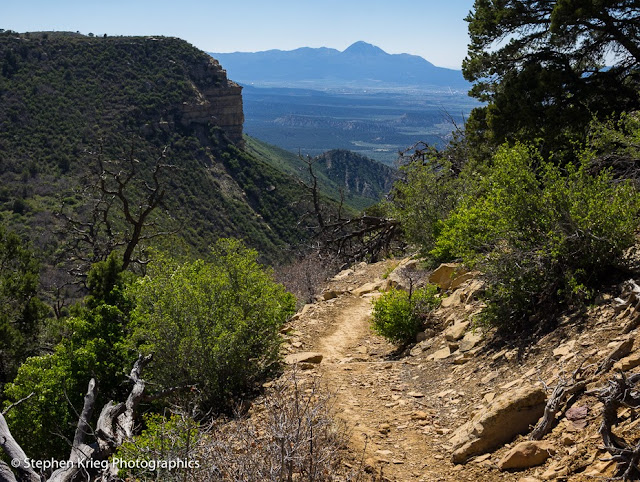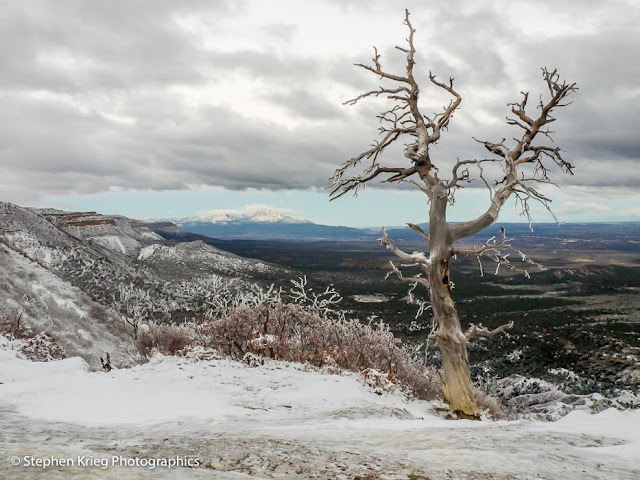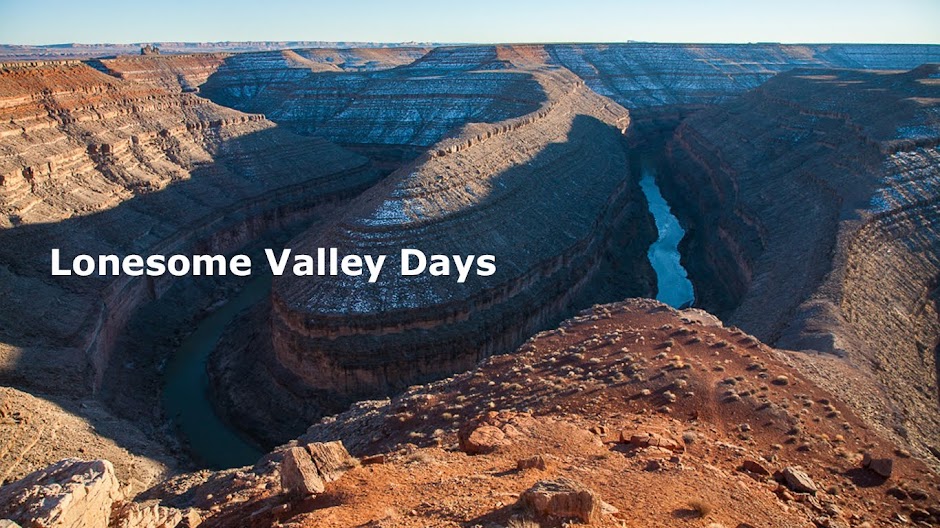Tuesday, October 3, 2017
Last Dollar Road, Last Day of September
Driving up into the San Juan Mountains of southwest Colorado, I hooked a right turn onto Last Dollar Road. Always worth it.
The fall aspen colors were not quite at their peak, despite some early snows. Light snows. The aspen forests seemed to be sitting it out for another day, week, whatever before casting their leaves for the winter.
Since fall is my favorite time of year, I was in no hurry to see it go any faster than necessary.
© Copyright 2017 Stephen J. Krieg
Friday, May 5, 2017
Mesa Verde: the Green Table-Mountain is Greening Up
 |
| Point Lookout Trail, along the North Rim, Mesa Verde National Park. |
It's a high table, deeply dissected by canyons that flow (when there is any flowing water) to the south. The "mesa" is also titled toward the south. Between these two conditions, it came to be home to the largest cliff dwellings in North America.
 |
| Square Tower House cliff dwelling, Mesa Verde. |
 |
| Point Lookout, the very northern edge of Mesa Verde. |
 |
| From the northern edge of Point Lookout. |
 |
| Looking north from atop Point Lookout, onto the Mancos Valley and the La Plata Mountains. |
© Copyright 2017 Stephen J. Krieg
Tuesday, March 28, 2017
Mesa Verde in Early Spring
 |
| Sleeping Ute Mountain from Montezuma Valley Overlook, on the North Rim of Mesa Verde. |
The road was icy but not treacherous to my all wheel drive RAV4. No slipping and sliding, just go slowly.
At the Montezuma Valley Overlook I got out of my vehicle, but immediately pulled on my boots' traction devices. Otherwise it was apparent that I would be on my butt in just a step or two down the inclined sidewalk.
 |
| The icy sidewalk at Montezuma Valley Overlook, at dawn. |
 |
| Every photographer's favorite snag (standing dead tree) at Montezuma Valley Overlook. |
 |
| Snowy coating to the North Rim of Mesa Verde. It wouldn't last long. |
 |
| Icy road through one of the hillside cuts as sunrise colors tinge the clouds, Mesa Verde. |
 |
| Dry roads in the afternoon. |
 |
| Snow has melted on the south facing slopes and the road, anything not in shadow. |
 |
| Montezuma Valley Overlook in the afternoon. No need for traction devices anymore. You could have a picnic in the sun. |
© Copyright Stephen J. Krieg / Stephen Krieg Photographics
Saturday, January 21, 2017
In Between the Snows: Highway 211 to Indian Creek
 |
| An overnight dusting of snow on Entrada Sandstone along Highway 211. |
In certain conditions overcast skies can be an advantage: soft light. One can use that to their advantage. Particularly in the case of a snowy landscape, which highlights details that one otherwise might miss.
Driving north from Monticello on US 191, I turned west onto Utah-211, a scenic back road and the highway to the Needles District of Canyonlands National Park.
Not far from Hwy. 191 there are outcrops of Entrada Sandstone rising above the sagebrush flats. They are always nice to look at, but this morning with new snow, a light coating, I could see all the waves, folds, and joints in what was left of these sand dunes that had eons ago been turned into rock.
 |
| An column of sandstone along the cliff face. |
 |
| Highway 211 and eastern boundary of the BLM's Indian Creek Recreation Area. |
 |
| Fresh snow highlights the layers of the Kayenta Formation in Shay graben. |
A geology guide to this scenic drive says that this spot is called Shay graben. A graben is where there are two parallel faults in the Earth's crust--breaks--and the block in between has downdropped because of them. The red layer is the Kayenta Formation, which the upper flats sit on. The highway is now dropping down through the graben to get down to Indian Creek canyon.
At any rate, I stop a couple of times to photograph the Juniper and Pinyon Pine dotted horizontal layers of the red Kayenta cliffs, set off by the snow coating.
 |
| Kayenta Formation red cliffs in Shay graben. |
 |
| Newspaper Rock archaeological site, Indian Creek at Highway 211. |
Shortly after Newspaper Rock the elevation became too low for last night's snow to stick. So I turned around and headed back up to the flats.
Photo location: northern San Juan County, southeast Utah.
See more of my landscape and nature photography on my website at: www.naturalmoment.com.
© Copyright 2017 Stephen J. Krieg
Subscribe to:
Posts (Atom)


